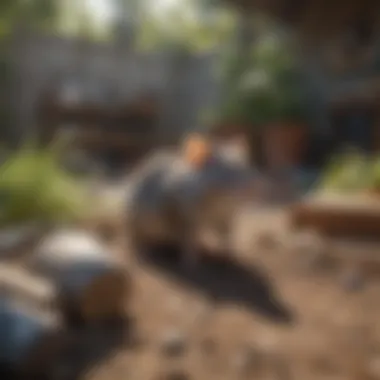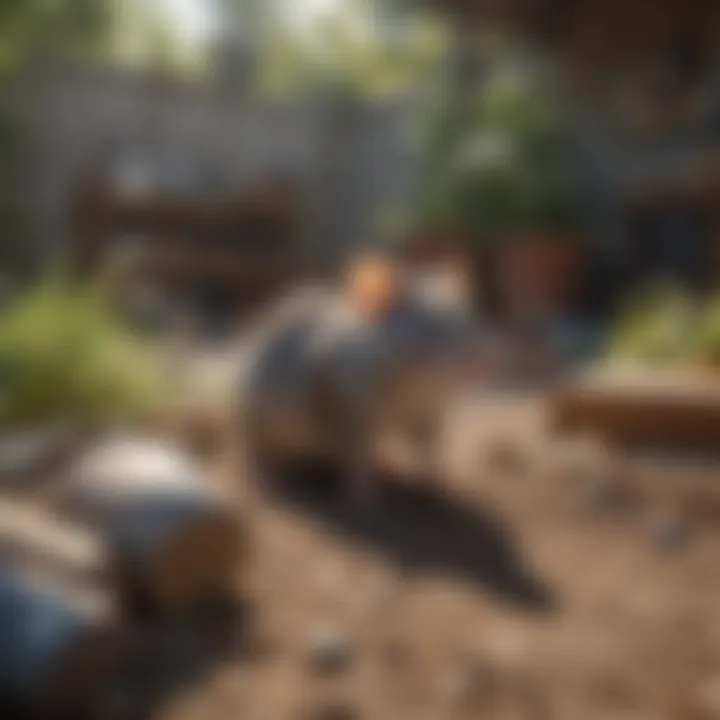Effective Strategies for Eliminating Yard Rats


Intro
Rats are not just nuisances; they can be carriers of disease and can cause significant damage to property. Having an infestation in your yard can lead to a lot of stress for homeowners. Therefore, knowing effective strategies to tackle this issue is essential. This section explores the different facets of understanding these pests while establishing a foundation for the strategies we will discuss later.
Understanding the Pest
Identification
Identifying rats in your yard is the crucial first step in dealing with an infestation. Common types include the Norway rat and the roof rat. Norway rats are larger, burrowers, and often found in basements and sewers, while roof rats are more agile and typically inhabit trees and upper spaces.
Look for signs like droppings, footprints, and gnaw marks. Rat droppings are dark and cylindrical, usually about the size of a raisin.
Life Cycle
Understanding the life cycle of a rat can aid in control strategies. Rats typically breed through a rapid cycle; a female rat can give birth up to five times a year, with each litter consisting of around seven to twelve pups. They can reach maturity within three months, meaning populations can escalate quickly if not managed early.
"An understanding of the rat's biology is essential for effective control measures."
Pest Prevention Strategies
Environment Modification
Preventing rats from settling in requires environmental adjustments. Keeping the yard clean is essential. This includes:
- Regularly trimming bushes and plants to eliminate nesting sites.
- Properly storing food and trash. Use sealed containers for garbage and pet food.
- Removing outdoor water sources like ponds or bird baths to limit hydration options.
Physical Barriers
Physical barriers serve as a tangible deterrent against rats. Garden fencing made of solid materials helps keep them out. Ensure that there are no gaps, as rats can squeeze through small openings. Additionally, consider:
- Closing holes in structures, like attics or basements.
- Using tight-fitting lids on compost bins to prevent access.
- Employing metal mesh around essential areas as a safeguard.
Control Methods
Chemical Control
If prevention fails, chemical control may become necessary. While there are various rodenticides available, Bromethalin and Brodifacoum are some of the commonly used choices. However, it is vital to read instructions carefully and consider safety implications, especially if pets or children are in the vicinity.
Biological Control
In some cases, introducing natural predators can help in managing rat populations. For example, keeping cats can deter rats, as their natural instinct is to hunt rodents. However, relying solely on biological control may not always be effective depending on the levels of infestation.
In the quest for creating a rat-free yard, understanding the pest, implementing prevention strategies, and using control methods effectively will form a comprehensive plan. The road to a rat-free environment is multilayered and requires diligence.
Understanding Rat Behavior
Common Species in Urban Areas
In urban settings, two primary species of rats are commonly found: the Norway rat and the roof rat. The Norway rat is larger, typically brown, and prefers burrowing near the ground. It thrives in basements, sewers, and other low-lying areas. In contrast, the roof rat is smaller and usually has a black coat. This species is adept at climbing. It tends to inhabit higher locations like attics and trees, making access to food sources stored at height easier.
Identifying these species is essential. Each has unique habits, diets, and nesting preferences, requiring tailored removal strategies.
Habitat Preferences
Rats exhibit specific habitat preferences that align with their needs for safety, food, and reproduction. They prefer areas that offer shelter and are close to food access. Common shelter sources include:
- Dense vegetation like shrubs or unkempt gardens.
- Wood piles or stacked materials that provide safe hiding spots.
- Buildings with gaps, cracks, or holes that provide entry points.
Understanding these preferences helps in altering your yard. Cutting back shrubs, sealing holes, and minimizing clutter can discourage rat habitation.
Feeding Habits
Rats are opportunistic feeders. They consume a wide range of foods, including grains, fruits, and even garbage. Often, they are attracted to leftover pet food and unsecured compost heaps. Recognizing their feeding habits allows homeowners to effectively:
- Secure trash cans with tight-fitting lids.
- Store pet food in sealed containers and not on porches or lawns.
- Clean up any spills or leftover food outdoors immediately.
By removing easy food sources, you can significantly reduce the chance of inviting these pests into your space.
Overall, understanding rat behavior can transform your approach to pest control. It empowers you with the knowledge necessary to not only eliminate current infestations but also prevent future ones effectively.
Identifying Signs of Infestation
Understanding the signs of rat infestation is critical for homeowners. Early detection can prevent more extensive damage and health risks. Rats reproduce quickly. If left unchecked, a small problem can become a major issue. Knowing what to look for ensures timely action.
Physical Evidence
Physical evidence can manifest in various forms. Common signs include gnawed items, such as furniture, wires, and even walls. Rats often leave behind bite marks that can be distinctive. Another indicator is hollow or caved-in areas in walls or floors, suggesting nesting activity.
If you notice torn materials, such as fabric or insulation, these may also signal rat activity.
Furthermore, you may see oily smudges along surfaces where rats frequently move. This is caused by the natural oils in their fur. These marks can often be subtle, requiring closer inspection. You should check around entry points, like doors and windows, as these areas may collect dirt.
Nocturnal Activity
Rats are primarily nocturnal creatures, meaning they are most active during the night. If you hear unusual noises—scratching or rustling sounds—especially after dusk, it could indicate infestation. Many householders may not notice right away, as daytime activity tends to be limited.
Listening for these signs around dusk or dawn is effective. You might hear them scurrying or chewing. This auditory clue can be a red flag of their presence.
Even more, the sudden disappearance of food or significant changes in trash levels can suggest nocturnal scavenging habits. When trash bins seem disturbed, or food seems to vanish faster than usual, it may indicate that rats are foraging.
Scat and Tracks
Droppings, or scat, are one of the most telling signs of a rat infestation. Rat droppings are typically dark, about half an inch long, and tapered at the ends. Finding these in areas like cupboards or near food supplies can alert you to a problem. It’s essential to distinguish between rodent types. For example, a mouse’s droppings are smaller and more pointed compared to rats.
Additionally, tracks can provide clues. Rats tend to leave footprints in dusty areas. Look for small, paw print shapes with five toes on their front paws and four on the back. If you spot tracks, chances are you have some rats in your yard.
In summary, identifying the signs of rat infestation ensures that you can take proactive measures to eliminate them safely, protecting your home and your health.
Environmental Factors Attracting Rats


Understanding environmental factors that attract rats is crucial in pest management. Without addressing these factors, any control efforts may prove futile. Rats are adaptable creatures that thrive in conditions that provide shelter, food, and water. Identifying and managing these habitats allows homeowners to significantly reduce the likelihood of infestation.
Food Sources
Food availability draws rats like a magnet. Common food sources in residential areas include pet food left outdoors, birdseed, and fallen fruits or nuts. Homeowners often overlook the importance of proper food storage.
- Store pet food in airtight containers.
- Regularly clean up fallen food in gardens.
- Dispose of kitchen scraps promptly; composting should be done carefully to avoid attracting rodents.
By eliminating these easy food sources, the chances of attracting rats diminish.
Shelter Options
Rats seek refuge in sheltered spaces. They prefer darker areas with adequate hiding spots, which can include:
- Overgrown vegetation and dense shrubs in yards.
- Cluttered garages, basements, or sheds.
- Under decks, porches, or fences that provide concealment.
To discourage rats from nesting, homeowners should maintain their yards and minimize clutter. Trimming back vegetation and organizing storage areas can make environments less inviting.
Water Accessibility
Access to water is another significant factor in attracting rats. They require a consistent source of hydration. Areas in yards that can retain water, like:
- Birdbaths that are not regularly cleaned.
- Clogged gutters or stagnant water in containers.
- Leaky faucets or hoses.
Need to be addressed. Homeowners should regularly check for leaks and remove standing water. This step not only helps prevent rat infestations but also encourages better overall hygiene in outdoor spaces.
"Effective rat control starts with understanding their needs and adjusting the environment accordingly."
By managing food sources, shelter, and water accessibility, homeowners can create an environment that is less hospitable to rats. This foundational aspect of prevention is vital to successful rat management.
Preventative Measures
Preventative measures are the foundation of effective rat control. Rather than responding to an infestation after it occurs, implementing proactive strategies can significantly reduce the likelihood of rats making a home in your yard. Understanding the behaviors and habits of rats allows homeowners to create an environment that discourages their presence.
Incorporating preventative strategies can also be more cost-effective in the long term. Avoiding a serious infestation is better than dealing with the consequences, which can include property damage and health risks associated with pests.
Landscaping for Deterrence
Landscaping plays a crucial role in preventing rats from invading your outdoor spaces. By choosing certain plants and arranging your yard wisely, you can create an unwelcoming environment.
- Choose dense plants sparingly: Dense shrubbery provides ideal cover for rats. Instead, opt for more open spaces and low-growing plants.
- Regular maintenance: Keep your garden tidy. Trim hedges, mow lawns, and remove fallen branches to limit hiding spots for rats.
- Use mulch judiciously: While mulch is excellent for gardens, excessive amounts could provide shelter. Use it wisely and avoid pile-ups.
- Create barriers: Installing fences or barriers can also limit access. Make sure they are buried at least a foot into the ground to prevent burrowing.
Securing Food and Debris
Food sources and debris are significant attractants for rats. Eliminating these will greatly reduce their incentive to frequent your yard.
- Store food properly: Ensure pet food, bird seed, and other food products are kept in sealed containers. Do not leave dishes out for pets overnight.
- Compost carefully: If you compost, avoid adding meat or dairy, which can attract rats.
- Regular waste disposal: Keep trash bins sealed tightly. Dispose of waste regularly to remove potential food sources.
- Remove fallen fruits and nuts: If you have fruit trees, it is essential to collect and dispose of any fallen produce promptly.
Regular Cleaning Practices
Maintaining cleanliness is crucial to avoiding rat infestations. Developing a routine can minimize risks significantly.
- Regular yard clean-up: Remove clutter, debris, and any potential nesting sites regularly. This includes piles of wood, construction materials, or any neglected areas.
- Patio and deck upkeep: Keep outdoor eating areas clean. Remove any crumbs and drink spills immediately.
- Check drainage systems: Ensure that drainage systems are working properly. Standing water can attract rats, and clogged drains can create breeding grounds.
Regular vigilance can prevent rat populations from establishing themselves in your environment.
Implementing these preventative measures requires minimal effort but can yield significant benefits. Ensuring your yard remains unattractive to rats is essential for long-term success in pest control.
Trapping Techniques
Trapping techniques are an essential component in the fight against rat infestations. These methods provide effective immediate control and are part of a broader integrated pest management strategy. They help reduce the rat population while minimizing risks to non-target species and the environment. By selecting suitable traps and employing them correctly, homeowners can significantly enhance their chances of successful rodent removal.
Types of Traps
There are several types of traps available for capturing rats, each with its unique features and benefits. Understanding these traps allows for more informed decisions when addressing a rat problem.
- Snap Traps: These are traditional traps that kill rats instantly when activated. They are one of the most humane options if used properly and can be placed in areas where rats frequent.
- Glue Traps: These traps use a sticky substance to catch rats. They can be effective in closed spaces, but may lead to prolonged suffering for the captured rat, raising ethical concerns.
- Live Traps: Also known as catch-and-release traps, these allow for the humane capture of rats. It is essential to check local laws regarding their release to ensure compliance.
- Electric Traps: These devices deliver a quick, lethal shock to the rat. They are easy to use and require minimal maintenance while providing a humane alternative.
Choosing the right type of trap depends on the specific situation, including the level of infestation and the location of the traps.
Proper Placement of Traps
The effectiveness of trapping techniques largely depends on the placement of the traps. Proper placement maximizes encounters with the targeted rodents. Here are some considerations for setting traps:
- Identify High Traffic Areas: Look for signs such as droppings, gnaw marks, or burrows to locate areas with active rat movement.
- Positioning: When placing snap traps, ensure they are positioned parallel to the wall, as rats tend to travel along the edges. Leave enough space between traps to avoid overcrowding and maximize capture efficiency.
- Avoid Disturbance: Position traps where they are unlikely to be disturbed by pets or humans. This not only protects non-target animals but also increases the chances of catching rats.
- Use Bait Strategically: Certain foods can be used as bait, such as peanut butter or dried fruit. Place bait in a way that encourages the rat to interact with the trap without triggering it prematurely.
Checking and Maintaining Traps
Regular monitoring and maintenance of traps are crucial for ensuring their ongoing effectiveness. This involves:
- Frequent Checks: Traps should be checked at least once daily, as this prevents any prolonged suffering and allows for quick removal of captured rats.
- Cleaning: Occasionally, traps might accumulate debris or odors that can deter rats. Keep them clean to ensure they remain attractive for future captures.
- Adjustments: If traps are not catching any rats, consider rearranging them based on new signs of activity or experimenting with different bait to improve effectiveness.
- Safety Disposal: Properly dispose of any captured rats in accordance with local regulations. This not only ensures compliance but also addresses potential health risks associated with rodent handling.
Effective trap management can drastically reduce rodent populations and restore harmony to your outdoor spaces.
Chemical Control Methods
Chemical control methods play a significant role in managing rat populations, especially when other strategies fail to yield results. Understanding how to utilize these methods effectively can be crucial for homeowners frustrated by ongoing infestations. This section delves into rodenticides, essential safety measures, and environmental impacts, enabling you to make informed choices about dealing with rats in your yard.
Rodenticides Overview
Rodenticides are chemical substances designed to control rodent populations. There are mainly two types: anticoagulants and acute toxins. Anticoagulants, such as bromadiolone, work by preventing blood clotting, leading to internal bleeding in rodents. They require multiple doses for effectiveness. Acute toxins, like zinc phosphide, cause immediate death but often need careful handling. It is essential to choose the right type based on the level of infestation and specific circumstances.
Important: Always read instructions carefully and ensure proper application.
Safety Precautions
Using rodenticides comes with inherent risks, particularly to children, pets, and non-target wildlife. To minimize risks, adhere to the following safety precautions:
- Read Labels Thoroughly: Understanding the product details is vital. Labels provide essential information about dosage and potential hazards.
- Choose Bait Stations: Enclosed bait stations can protect other animals from exposure while providing access to the intended target.
- Keep Away From Reach: Rodenticides should only be placed in locations inaccessible to children and pets.
- Use Gloves: Wear gloves during application to protect skin from harmful chemicals.
- Dispose Properly: Follow local guidelines for disposal to prevent contamination.
Environmental Impact Considerations


The impact of chemical control methods extends beyond targeted pests. Rodenticides can affect non-target species, including beneficial wildlife and pets, raising ethical dilemmas. Key considerations include:
- Secondary Poisoning: Animals that feed on poisoned rats may also become affected. This happens more frequently in areas with high biodiversity.
- Longevity of Chemicals: Some rodenticides persist in the environment for extended periods, leading to ecological imbalance.
- Integrated Pest Management: Using chemical methods should be part of a broader strategy that includes preventive measures and monitoring.
In summary, chemical control methods can provide an effective means of dealing with rat infestations. However, responsible use is paramount to safeguard human health and protect the environment.
Natural Deterrents
Natural deterrents play an important role in managing rats effectively and sustainably. These methods offer a less toxic alternative to traditional pest control. Homeowners can leverage various organic substances to create an environment less appealing to rodents. The emphasis on natural solutions aligns with a growing awareness of eco-friendly practices in pest management. By using natural deterrents, individuals can protect their outdoor areas without relying heavily on chemical interventions.
Essential Oils and Scents
Essential oils have gained attention for their potential to repel rats. Many oils possess strong scents that can be off-putting to rodents. Oils like peppermint, lavender, and eucalyptus can be used to create barrier zones around the yard.
- Application Methods: You can soak cotton balls in essential oils and place them in areas where rat activity is suspected. Another option is to mix oils with water and spray the mixture around plants and entry points.
- Frequency: It is essential to reapply these oils regularly, especially after rain or heavy dew, as their effectiveness diminishes over time.
Using essential oils is an organic way to deter rats and adds aromatic qualities to your space. Consider selecting oils based on personal preference and their specific effects on rodent behavior.
Predator Urine
Predator urine serves as a natural method of deterring rats by mimicking the presence of their natural predators, such as foxes or coyotes. This can create an environment where rats feel threatened and will avoid areas treated with such products.
- Availability: Many commercial products are available that use predator urine. These can be sprayed or sprinkled in strategic locations around the yard.
- Efficacy: While their effectiveness can vary, many users report positive results, especially in areas where rodent activity is high. The smell can dissuade rats and encourage them to relocate elsewhere.
Plant-Based Repellents
Certain plants possess properties that naturally repel rats. Incorporating these plants into your garden can enhance the natural defenses of your yard. For example, plants such as mint, rosemary, and garlic are known for their scent, which is typically unappealing to rodents.
- Garden Planning: Planting these varieties in strategic locations can act as a barrier that rats may avoid. Consider planting them along the perimeter of your yard or near entry points commonly used by pests.
- Maintenance: Keeping these plants healthy ensures their oils and scents remain potent, providing ongoing protection against infestation. Regular pruning and watering can optimize their repellent effects.
"Utilizing natural deterrents not only addresses rat issues but also encourages an eco-friendly approach to pest control. This reflects a shift towards harmonious living with nature."
Creating Unfavorable Conditions
Creating unfavorable conditions is a fundamental aspect of managing rat populations effectively. This process involves modifying the environment in ways that make it less appealing for rodents. By understanding the key factors that attract rats, homeowners can take proactive steps to discourage their presence. The importance of this strategy lies in its capacity to create a long-term solution that complements other pest control methods. It also minimizes reliance on traps or chemicals by addressing the root causes of the infestation.
Reducing Shelter Opportunities
Rats thrive in environments that offer ample shelter. They typically seek out warm, dark spaces to nest and raise their young. Homeowners should aim to identify and eliminate these shelter opportunities around their property. Begin by inspecting the yard for potential nesting sites, particularly in overgrown vegetation, piles of debris, or stacks of firewood. Here are several steps to consider:
- Trim back bushes and shrubs that are close to the house.
- Remove any unnecessary clutter from the yard, such as old furniture or trash.
- Close off entry points to sheds, garages, or crawl spaces by sealing gaps and cracks.
Taking these measures creates a less inviting habitat for rats and significantly reduces the likelihood of infestation.
Removing Food Sources
Rats are resourceful creatures that will exploit any available food source. As such, removing these sources is crucial in discouraging their presence. Homeowners must be vigilant in their sanitation efforts, ensuring that food is not easily accessible. Key actions include:
- Store pet food and birdseed in sealed containers.
- Promptly pick up fallen fruits, nuts, and seeds from yards.
- Ensure that compost piles are secure and do not attract rodents.
A clean yard is less likely to attract rats. The fewer food sources available, the more they will seek their meals elsewhere.
By addressing food sources, homeowners can significantly lower the risk of rats discovering their property as a suitable place to congregate.
Controlling Water Areas
Water is an essential resource for all living creatures, including rats. Controlling areas of stagnant or standing water can greatly benefit rat control efforts. To create an environment less favorable to rats, consider the following approaches:
- Fix any leaking taps or pipes to eliminate water leaks.
- Regularly check for pools of water in gutters or around downspouts and clear them out.
- Ensure that there are no containers in the yard that can collect rainwater.
Taking action to control water sources strips rats of essential resources.
In summary, creating unfavorable conditions involves a multifaceted approach. Homeowners can reduce shelter opportunities, eliminate food sources, and control water areas to deter rats effectively. These practical steps contribute to an overall strategy aimed at long-term rat management.
Ethical Considerations in Pest Control
Addressing rat infestations in outdoor spaces must go beyond mere eradication techniques. The focus should also extend to ethical considerations that resonate with environmental responsibility and humane treatment of all creatures, including rats. Understanding the ethical implications is crucial in fostering a sustainable approach to pest control. Ignoring these factors can lead to unnecessary suffering for the rodents and potential environmental consequences. In this section, we will discuss the importance of humane treatment options and the balancing act between effective control measures and ethical standards.
Humane Treatment Options
Humane treatment options focus on methods that minimize harm to rats while addressing the issues they cause. One popular approach in pest control that adheres to humane principles is live trapping. This method involves the use of traps designed to capture rats without causing injury or death. After capture, the trapped animals can then be released far away from residential areas. However, it is vital to check traps regularly to ensure that the captured animals do not suffer from dehydration or starvation.
Additionally, many opt to use repellent strategies rather than lethal approaches. Utilizing natural repellents like essential oils, predator scents, or even motion detectors can dissuade rats from invading yards without harming them.
"In pest control, ethical considerations should guide choices between lethality and humane methods, ensuring respect for wildlife."
Long-term Solutions vs. Short-term Fixes
When tackling rat problems, it is critical to weigh long-term solutions against short-term fixes. Short-term methods tend to offer immediate relief but may not effectively prevent future infestations. For example, while using rodenticides can rapidly reduce rat populations, it does not address the underlying issues that attract these pests, such as food sources or shelter.
Conversely, long-term solutions involve a comprehensive understanding of the factors contributing to infestations and implementing preventative measures. This may include better waste management, habitat modification, and consistent property maintenance. By fostering an environment that is less attractive to rats, homeowners can significantly reduce the chances of re-infestation.
Ultimately, the goal should not only be to eliminate rats but also to create lasting changes that safeguard both health and wildlife. Each decision made in pest control practice should reflect a careful balance between effectiveness and empathy towards the ecosystem.
Engaging Professional Help
When dealing with a rat infestation in your yard, knowing when to seek professional assistance is crucial. Rats can multiply rapidly, and their presence often signals an underlying issue that may be difficult to manage with DIY methods alone. Engaging professional pest control services can offer numerous benefits that save time and effort while ensuring a thorough approach to the problem.
When to Call an Exterminator
Identifying the signs of rat activity is essential in deciding to call in a professional. If you notice increased droppings, chew marks, or nests, it’s time to take action. Additionally, if you see rats during the day, it indicates a significant problem.
- Health Risks: Rats can transmit diseases, making it vital to address an infestation promptly.
- Property Damage: They often cause damage to insulation, wiring, and structural elements in homes.
Waiting too long can lead to escalating damage and increased health risks for you and your family. Thus, recognizing these signs early on can prevent larger issues down the line.
Evaluating Pest Control Services
Choosing the right pest control service requires careful consideration. Not all exterminators offer the same level of expertise or service quality. Here are some elements to keep in mind:
- Credentials: Check if they are licensed and insured. Proper certification often indicates professionalism.
- Experience: Look for companies that specialize in rodent control. Experience in dealing with rats specifically can lead to more effective solutions.
- Methods Used: Inquire about their approach. Do they focus on humane methods? Are they utilizing the latest technology? Understanding their process will ensure alignment with your values.


Reading reviews and testimonials from other customers can also provide insight into their reliability and effectiveness.
Cost Considerations
Understanding the costs associated with pest control services is important as well. The price to hire an exterminator can vary based on several factors:
- Severity of Infestation: Greater infestations often require more extensive treatments.
- Location: Prices may vary based on geographical area and local competing services.
- Service Packages: Some companies offer monthly or annual service plans, which may save money over time.
- Initial Inspection Fees: Many companies charge for an initial inspection, which can be a factor in the overall cost.
Receiving multiple quotes can help you gauge the standard pricing in your area and allow for informed decision-making. Ultimately, the cost must be balanced with the potential for property damage and health risks inherent with a rat infestation.
Monitoring and Follow-up
Monitoring and follow-up are crucial components of effective pest control strategies, especially when it comes to eliminating rats from your yard. Once you have initiated control measures, the need for consistent observation cannot be understated. Regularly monitoring the situation allows for timely adjustments and the prevention of recurrence.
Tracking Signs of Rat Activity
Identifying signs of rat activity is essential for understanding their behavior and movement patterns. You should look for physical evidences such as droppings, gnaw marks, and nests in hidden areas like bushes or under decks.
Some common signs to track include:
- Droppings: Fresh droppings are usually moist and dark. They become hard and grey as they age.
- Gnaw marks: Examine wooden structures and garden beds for gnaw marks, which indicate rat activity.
- Nests: Look for nests made of shredded material, which often resemble small clumps of insulation or shredded paper.
- Tracks: In soft soil or dust, you might see footprints which can help identify the presence of rats.
Utilizing traps during this phase can also help you gauge the level of rat activity. Setting out traps strategically will provide insights into the specific areas they frequent most.
Adjusting Control Strategies
As you observe signs of rat activity, it is important to adapt your strategies to enhance effectiveness. This can involve several considerations:
- Assessing Effectiveness: If you continuously find signs of activity, reassess the methods you are using. Are the traps functioning adequately? Is the bait appealing enough?
- Expanding Trapping Areas: If rats are not caught in the initial traps, consider expanding the trapping area to include new locations where signs have appeared.
- Exploring Alternatives: If regular traps show limited results, consider alternative options like using chemical methods or natural deterrents.
"Continuous adjustment and real-time response to observations on rat activity can significantly enhance the effectiveness of your pest management strategies."
By being vigilant and proactive in your monitoring and follow-up, you stand a much higher chance of successfully eliminating rats from your yard. Remember, persistent observation and adjustments are keys to preventing future infestations.
Community Approaches to Rat Control
Community approaches to rat control are crucial in tackling infestations that extend beyond individual properties. Rats do not recognize property lines, and their populations can thrive in environments where collaborative efforts are absent. Understanding the importance of collective action is essential for effective management. Through community involvement, it is possible to establish a unified front against rat populations, ensuring better outcomes for everyone involved.
By working together, residents can create a comprehensive strategy. This strategy encompasses not only immediate measures to control existing populations but also long-term prevention efforts. Collaborating reduces the wasted effort of individual homeowners fighting the same issue separately. Here are several key elements:
- Resource Sharing: Communities can pool resources for pest control services, making it more affordable for all members.
- Shared Knowledge: Residents can exchange information on effective strategies, traps, and local pest control services.
- Increased Awareness: Community efforts raise awareness of the signs of rat infestations and encourage prompt action.
Collaborative Initiatives
Collaborative initiatives refer to programs or partnerships formed within a community. These could involve local government, non-profit organizations, and resident associations. Such cooperation allows for a systematic approach to rat control.
For instance, communal cleanup days can be organized. In these events, residents come together to clean up areas that attract rats. This might include:
- Removing Debris: Clearing out rubbish, leaf piles, and other debris that can serve as shelter.
- Securing Garbage: Ensuring that all waste is stored in rat-proof bins.
- Landscaping Improvements: Implementing landscaping changes to reduce hiding spots for rats.
These initiatives foster a sense of community responsibility and can significantly reduce rat populations in shared spaces. A unified effort creates stronger community bonds and leads to sustainable management solutions.
Educational Campaigns
Educational campaigns serve to inform residents about the importance of proactive steps in rat control. By sharing knowledge, communities can equip members with the tools they need to take action effectively. These campaigns can take various forms:
- Workshops: Hosting sessions on pest control techniques, such as trapping and exclusion methods.
- Information Flyers: Distributing materials that outline proper sanitation practices and preventive measures.
- Social Media Outreach: Using platforms like Facebook or Reddit to circulate information and updates about local rat control initiatives.
Understanding rodent behavior, the environmental factors contributing to infestations, and the array of control methods can empower residents. An informed community is better suited to manage rat populations effectively.
Collective efforts in rat control do not only protect individual homes but also enhance overall neighborhood health and safety.
Legal Regulations Surrounding Pest Control
Understanding the legal landscape surrounding pest control is essential for homeowners and professionals alike. Regulations vary by region and dictate how pest control can be carried out, ensuring that methods used are both effective and humane. Adhering to these regulations helps prevent liability issues and protects public health and the environment.
When dealing with rodents such as rats, it's crucial to be informed on the regulations specific to your locality. Many jurisdictions have laws regarding the use of certain chemicals and traps. Non-compliance can not only lead to fines but can also pose risks to pets and non-target wildlife.
Local Ordinances
Local ordinances related to pest control can encompass rules about what methods are permissible. These ordinances often exist to regulate the use of rodenticides to prevent unintended consequences. For instance, some cities may limit the types of traps or poisons that can be used due to environmental concerns, particularly in areas close to water sources or wildlife habitats. Homeowners should familiarize themselves with their local regulations to make informed decisions.
Understanding local ordinances can also lead to an awareness of community programs aimed at pest control. Many municipalities provide resources or incentives for proper pest management, enhancing collaborative efforts in reducing rat populations.
Compliance Requirements
Compliance requirements refer to the legal obligations that pest control operators and homeowners must follow when managing pest issues. These may include ensuring that all methods used are compliant with health and safety standards. Moreover, proper licensing may be necessary for any company that utilizes pesticides or traps in a professional capacity.
"Adhering to compliance requirements not only protects you legally but also demonstrates a commitment to responsible pest management."
Homeowners should keep records of pest control measures taken, especially if professional services are utilized. This documentation can prove beneficial in case of any disputes or inspections. Furthermore, understanding these requirements assists in selecting appropriate pest control methods that are safe and compliant.
Legal regulations are not mere formalities; they play a significant role in ensuring that pest control methods are safe for the community. Remaining informed about the rules and requirements relative to pest management can greatly influence the effectiveness and safety of efforts to eliminate rat infestations.
Staying Informed on Pest Management
Staying updated on pest management is crucial for maintaining a rat-free environment. Effective strategies require knowledge of rat behavior and local regulations. It helps in understanding what attracts rats and how to keep them away. Moreover, familiarity with evolving pest control techniques can lead to more effective solutions and prevent future infestations. By being informed, homeowners can respond swiftly to any signs of rat activity, potentially minimizing damage and health risks.
Knowledge is the first step in preventing and controlling pest infestations effectively.
Useful Resources
Several resources provide valuable information on pest management. Online platforms like Wikipedia offer articles on various pest species and control methods. Similarly, Britannica has in-depth entries on rat behavior and ecology, assisting homeowners in recognizing potential risks.
Local pest control associations often publish guidelines and tips tailored to specific regions. These documents can be particularly insightful as they address unique local pest challenges. Additionally, community forums like Reddit allow homeowners to share experiences and advice about pest control methods that worked for them.
Some recommended resources include:
Helpful Apps and Tools
Technology offers various applications and tools designed to assist in pest management. For example, apps allowing users to record sightings of rats or tracks can help in tracking infestation patterns. These types of tools offer visual identification references for common rat species.
Additionally, some pest control companies have developed mobile applications that provide step-by-step guides for homeowners. These apps often include:
- Identifying Signs: Pictures and descriptions to help recognize rat activity.
- Control Strategies: Practical suggestions tailored to specific infestations.
- Monitoring Tools: Track your progress over time.
Using technology can streamline the process of managing pest issues. Staying informed with available apps will ensure that homeowners can act effectively in the face of potential infestations.







